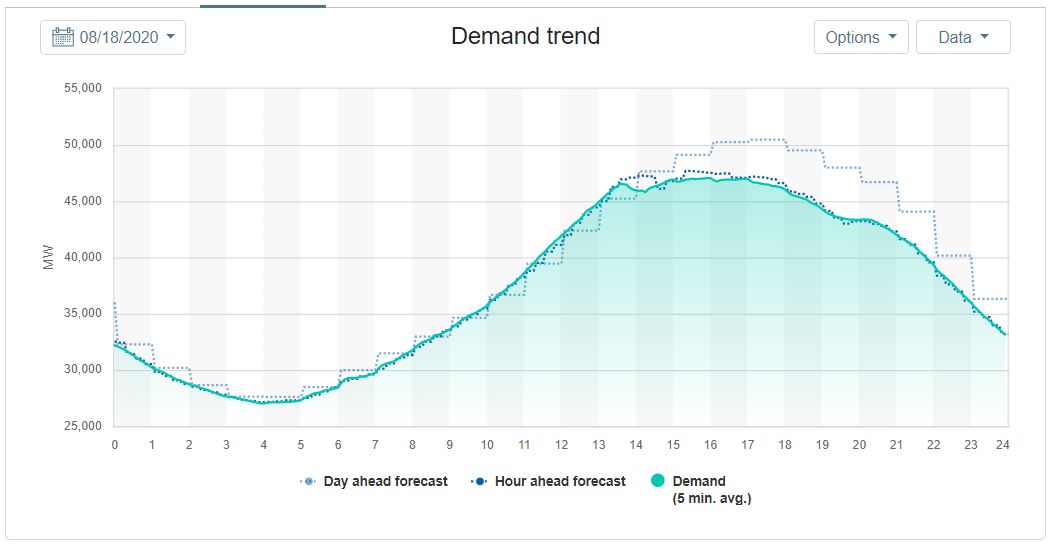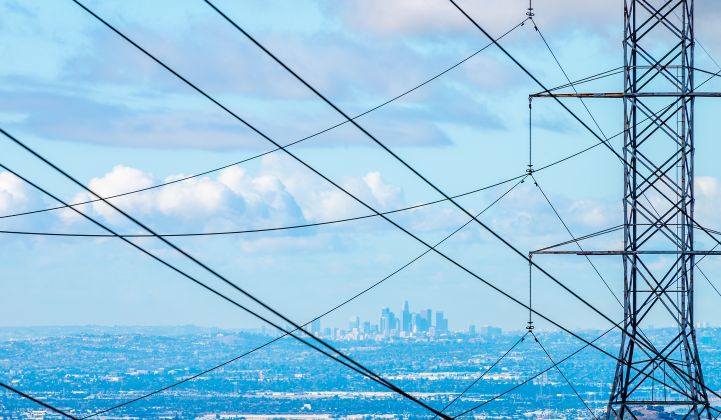After a massive heat wave in California that led grid operator CAISO to order its first rolling blackouts since the 2001 energy crisis on Friday and Saturday, the state has thus far managed to avoid further forced outages.
Although temperatures dropped a bit on Monday, California still faces excessive heat warnings similar to those issued last week, driving air-conditioning demand. CAISO has issued a "Flex Alert" asking Californians to conserve energy from 3 p.m. to 10 p.m. through at least Wednesday.
Meanwhile, heat waves have continued across the Western U.S., limiting the electricity available for import from other states, which California has relied on during previous heat-driven peaks. Several out-of-state power grids also reported emergency conditions on Monday and Tuesday.
But some things have changed since CAISO instituted its Stage 3 Electricity Emergency orders on Friday and Saturday. California residents have reduced their energy consumption, and utilities have been able to enlist backup generation during peak evening hours. Helpfully, CAISO has not reported any major generators unexpectedly dropping offline, as happened on both Friday and Saturday.
Conservation, demand response and backup generation
CAISO highlighted conservation as a key factor in a Tuesday evening statement, saying it was able to avoid rolling blackouts after demand levels turned out to be lower than expected. CAISO also was able to secure some scarce imported power, and wind power coming on late in the day helped too.
This chart of CAISO demand on Tuesday indicates that “actual loads were cruising along at a record pace,” Wade Schauer, Americas research director at Wood Mackenzie Power & Renewables, said. “Once the energy alerts and emergency appeals for customer conservation kicked in, they immediately dropped 1,000 megawatts of interruptible load and then eventually 4 to 5 gigawatts,” compared to the day-ahead forecast.

That load drop included efforts from California’s three major utilities. San Diego Gas & Electric issued mass media, text, phone call and email alerts asking customers to reduce energy use; it also triggered its demand response programs asking large customers to curtail power and residential customers to reduce air conditioning use, spokesperson Helen Gao said.
Southern California Edison has “fully utilized” demand response programs to reduce peak demand by more than 800 megawatts, including air conditioner and smart thermostat programs for more than 250,000 residential customers and interrupting industrial, commercial and water pumping loads at more than 1,300 businesses and farms, spokesperson Paul Griffo said.
SCE also tapped capacity bidding programs for utility-owned behind-the-meter battery systems to provide power, yielding approximately 5 megawatts, Griffo said. It has also called on 80 megawatts of commercial and indsutrial customer backup generation, which does include a subset of customer-owned batteries, he said. This indicates the potential for battery-equipped solar customers to help in offering grid support.
Pacific Gas & Electric engaged demand response from hundreds of large commercial and industrial “base interruptible” customers and hundreds of thousands of residential and small business customers, spokesperson Ari Vanrenen said. It also tapped 78.5 megawatts of diesel generators meant to support communities during its fire-prevention blackouts, after Gov. Gavin Newsom’s Monday emergency declaration permitting backup systems otherwise banned by state air pollution regulations.
Why did power plants drop offline?
Gov. Newsom’s office and California energy regulators are investigating why some key power plants went offline during Friday's and Saturday’s emergencies.
On Friday, the loss of a 475-megawatt power plant around 3 p.m. started a series of events that led to CAISO declaring a Stage 2 emergency, dispatching 800 megawatts of demand response around 5 p.m.; by 6:30 p.m., it called a Stage 3 emergency requiring the state’s utilities to shed a total of 1,000 megawatts of load to stabilize the system by just before 8 p.m.
On Saturday, after struggling to keep the grid stable after losing about 1,000 megawatts of wind power, CAISO saw a generator quickly ramp down its 400 megawatts of output at around 6:15 p.m. That forced CAISO to order rolling blackouts 10 minutes later to drop 470 megawatts of load. It ended the demand about 30 minutes later as demand began to fall and wind power ramped back up.
CAISO hasn’t identified the power plants in question, but they could be natural-gas-fired plants, since those make up most of the state’s fleet. High heat can cause problems for power plants that can force them to shut down.
California’s experience during the 2001 energy crisis — when now-disgraced energy company Enron and other power plant operators manipulated markets by taking power plants offline under the guise of maintenance issues to force wholesale prices upward — has primed state leaders to be on the lookout for similar issues.
Long-term challenges to resource adequacy regime
On Monday, CAISO President Stephen Berberich laid the blame for the rolling blackouts on a gap in California’s reserves of generation capacity to manage late evening “net peak” in energy demand — a measure of total demand minus renewable energy's contribution. California's increasing share of solar power pushes this net peak out about two hours later than the overall “gross peak” in demand, as this chart of CAISO demand-supply data from Wood Mackenzie shows.

Berberich didn’t blame solar power for the rolling blackouts. Rather, he accused the California Public Utilities Commission of failing to heed CAISO’s warning that it will need about 4,700 megawatts of additional grid capacity by 2022, including additional resources starting this year, to manage demand peaks as the sun is going down.
He labeled as inadequate CPUC’s order last year for 3,300 megawatts of capacity by 2023 under its Resource Adequacy program, half of it to be available by mid-2021. PG&E and SCE have both contracted massive amounts of battery storage projects under that order, and the state’s community-choice aggregators (CCAs) are also securing clean energy and storage resources to meet their requirements.
On Monday, the CPUC said it is investigating the “supply deficiencies” that led to Friday's and Saturday’s rolling blackouts. Utilities and CCAs “procured the resources that were required to meet the forecasts,” CPUC spokesperson Terrie Prosper said. “The question we’re tackling is why certain resources were not available.”
Berberich also called for changes in the CPUC-administered Resource Adequacy program to ensure that every hour of the day is adequately supplied to handle system “net peaks,” which are driven by the increasing amount of solar that reduces demand during sunlight hours but causes demand to spike as the sun goes down.
"Realistic views of what can be delivered from solar"
Prosper wrote that the CPUC’s Resource Adequacy program rules have been changed to discount solar value in meeting peak demand, but that “further revisions are likely to be necessary.” The CPUC is also examining its methods for identifying the proper amount of “reserve margin” required for grid stability during emergency conditions, she wrote.
Berberich’s comments underscore a growing tension between CAISO and the CPUC over how best to manage the state’s grid needs as it aims for 60 percent carbon-free energy by 2030 and 100 percent by midcentury. Beyond questions of whether to retire natural-gas plants early or keep them open longer, major challenges lie ahead in coordinating batteries, demand-side energy controls, electric vehicles and long-term energy storage to manage an increasingly solar-powered grid.
“We need to change the Resource Adequacy system,” CAISO board member Severin Borenstein said in Monday’s meeting, “including taking realistic views of what can be delivered from solar and when, and what can be delivered from demand response and when, and likewise for storage.”
Without such adaptations, “we could see more of these” blackouts in the future, Borenstein said.




